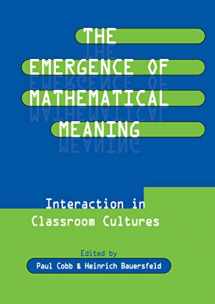
The Emergence of Mathematical Meaning: interaction in Classroom Cultures (Studies in Mathematical Thinking and Learning Series)
ISBN-13:
9780805817287
ISBN-10:
080581728X
Author:
Paul Cobb, Heinrich Bauersfeld
Publication date:
1995
Publisher:
Routledge
Format:
Hardcover
320 pages
FREE US shipping
Book details
ISBN-13:
9780805817287
ISBN-10:
080581728X
Author:
Paul Cobb, Heinrich Bauersfeld
Publication date:
1995
Publisher:
Routledge
Format:
Hardcover
320 pages
Summary
The Emergence of Mathematical Meaning: interaction in Classroom Cultures (Studies in Mathematical Thinking and Learning Series) (ISBN-13: 9780805817287 and ISBN-10: 080581728X), written by authors
Paul Cobb, Heinrich Bauersfeld, was published by Routledge in 1995.
With an overall rating of 3.5 stars, it's a notable title among other
books. You can easily purchase or rent The Emergence of Mathematical Meaning: interaction in Classroom Cultures (Studies in Mathematical Thinking and Learning Series) (Hardcover) from BooksRun,
along with many other new and used
books
and textbooks.
And, if you're looking to sell your copy, our current buyback offer is $0.3.
Description
This book grew out of a five-year collaboration between groups of American and German mathematics educators. The central issue addressed accounting for the messiness and complexity of mathematics learning and teaching as it occurs in classroom situations. The individual chapters are based on the view that psychological and sociological perspectives each tell half of a good story. To unify these concepts requires a combined approach that takes individual students' mathematical activity seriously while simultaneously seeing their activity as necessarily socially situated. Throughout their collaboration, the chapter authors shared a single set of video recordings and transcripts made in an American elementary classroom where instruction was generally compatible with recent reform recommendations. As a consequence, the book is much more than a compendium of loosely related papers. The combined approach taken by the authors draws on interactionism and ethnomethodology. Thus, it constitutes an alternative to Vygotskian and Soviet activity theory approaches. The specific topics discussed in individual chapters include small group collaboration and learning, the teacher's practice and growth, and language, discourse, and argumentation in the mathematics classroom. This collaborative effort is valuable to educators and psychologists interested in situated cognition and the relation between sociocultural processes and individual psychological processes.


We would LOVE it if you could help us and other readers by reviewing the book
Book review

Congratulations! We have received your book review.
{user}
{createdAt}
by {truncated_author}


